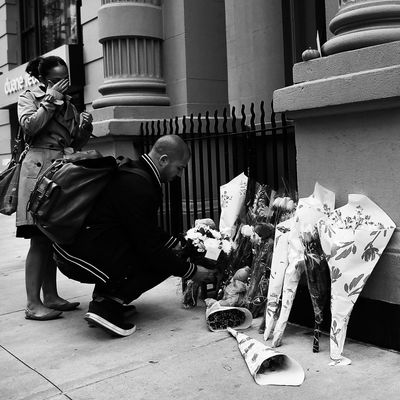
Michael Minahan didn’t know what to expect when he opened the bathroom door in Marina Krim’s Upper West Side apartment on October 25, 2012. The building super had been in his first-floor apartment when he heard screams. “They’re dead, they’re dead,” he recalled Krim saying. He ran in the direction she indicated — toward the bathroom in the back of her apartment, where nanny Yoselyn Ortega had killed two of Marina’s children: Lucia Krim, age 6, and Leo Krim, age 2.
“As soon as I opened the door, she turned right at me,” Minahan said. Ortega was facing the bathroom mirror, he said, covered in blood and holding a cloth to her throat, which she had just stabbed. It was the aftermath of what Marina Krim last week testified that she had seen moments before Minahan arrived. “I could see the tub and I could see, I would say, bodies or clothing or something” — only out of the corner of his eye. “I could see blood. I did my best not to take my eyes off Miss Ortega.” Whatever was in the tub, he knew he didn’t want a closer look. “I saw red,” he said. “I saw red.”
On the other side of the courtroom, Yoselyn Ortega sat still, staring straight forward, as has become her habit during the trial that will likely determine whether she spends the rest of her life in prison or in a mental-health facility, for the murders of two children she was paid to care for. Ortega has pleaded not guilty by reason of mental disease or defect to two counts of murder in the first and second degrees.
Minahan ran from the bloody scene. He pulled the front door to the apartment shut behind him. “I just grabbed the door handle, and I put my foot against the frame, and I held it with everything I got,” Minahan said, pantomiming with extended arms and leaning back. “I wasn’t letting nobody out of that apartment.” He wedged one foot against the door, calling to the building’s porter to bring the police to him.
“His face white. He was sweating and he was holding the door shut with his two hands and his foot,” NYPD officer Salvatore Provenzano later testified. “He said, ‘Whatever is behind that door is pure evil.’”
Provenzano and his partner, Bradley Gore, had been working at the site of a car accident a few blocks away when they heard the call for help on their radio. When they ran into the building, they saw Marina Krim wailing, her surviving 3-year-old daughter Nessie in her arms. Seeing their uniforms, Minahan ushered them into the apartment. By the time they arrived at the bathroom, Ortega was lying on the floor. She had one bloody knife by her side; a second knife was in the blood-covered sink. Gore stepped over a “moaning” Ortega to check the children for signs of life. He found none. Then Provenzano handed him a camera to preserve what they’d seen.
If Yoselyn Ortega reacted to the crime-scene photos that were displayed on a screen behind the witness booth, I didn’t see it. Before and after testimony, she sometimes speaks to her lawyers, gesturing with her hands and shaking her head, her long black ponytail shaking with it. But when the photo of her own bloody body flashed across the screen, she stared straight forward from her seat on the opposite side of the room. I wondered whether she could see the images — or whether, perhaps, she was practicing a form of tunnel vision, just as Minahan had done when confronted with the same tableau.
The final crime-scene photos presented to the jury did not appear on the screen. They were “photos of the male and female deceased in the tub,” as Detective Gore put it. After reviewing a folder that contained the photos, he handed them to a court officer, who handed them to the jury. One by one, the jurors took turns looking at the images, then handing them down the line. Several jurors shut their eyes after seeing the images. Others bowed their heads. Some wiped their eyes. Nobody made a sound, other than a handful of onlookers shifting in their seats. (One, a woman who was eager to tell me about a conspiracy theory she’d heard regarding this case, later asked if I knew whether the photo would be available to the public. With a knot in my stomach, I shook my head and turned away.)
As the jurors inspected the images, Ortega’s two lawyers leaned forward in their seats, seeming to study the jurors’ faces. One lawyer twirled a ballpoint pen. Yoselyn Ortega did not move.
Two medics who testified later in the afternoon described the scene as difficult to take in. “The bloodiest I’ve ever seen,” said Kevin Orr. “The worst I’ve ever seen, other than 911,” Eugene Nicholas reiterated.
“What did you do after your shift?” ADA Stuart Silberg asked Orr, whose reply was swift: “Called my four daughters and told them their daddy loved them.”




